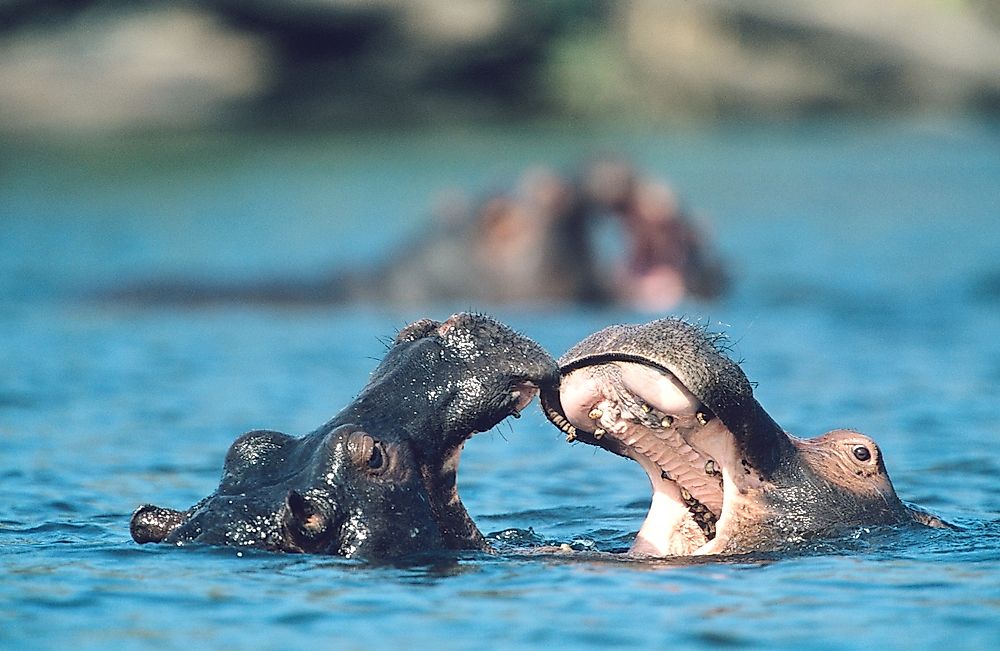Vulnerable Mammals of the Gambia

The West African state of Gambia is home to several species of vulnerable mammals. Political instability, environmental degradation, population growth, climate change, and human activities are the major reasons that have led to the decline in the numbers of these mammals. Here are the endangered species of mammals found in the country.
Vulnerable Mammals of the Gambia
Hippopotamus
A majority of the hippo inhabit the River Gambia National Park. They spend much of their time in the rivers, marshes, and swamps and move to dry land to feed. It is estimated that about 7000 hippos are left in West Africa. The IUCN Red List of Threatened Animals estimates that about 40 hippos are in Gambia. Uncontrolled poaching and lack of political goodwill in past governments led to a sharp decrease in the number of hippos. The same situation also affects the neighboring countries with Liberia or Mauritania among the countries with no hippos.
African Elephant
The African elephant is endangered in nearly every country. They are being hunted down for tusks that fetch high prices in the far east countries particularly China. In some African countries, elephants have been hunted to extinction including Gambia. The elephants of Gambia were hunted to extinction as far back as 1913. Today no elephants are roaming the wilderness of the Gambia.
Lions
The lions of Gambia suffered the same fate as the elephants. They were hunted down to extinction for sport and recreation. The IUCN Red List of Threatened Animals categorize the lions as a regionally extinct mammal. The lions roamed the parks of Gambia until they became extinct in 1940.
Leopard
The African Leopard is nearly extinct in Gambia. They are rarely seen, and the only evidence of their existence are footprints they leave behind. The IUCN Red List of Threatened Animals classified the leopard as nearly extinct in Gambia. The nocturnal mammal is known to inhabit the Kiang West and the national parks.
Sperm Whale
The cachalot or sperm whale is the largest toothed whale and toothed predator. It is considered a vulnerable animal by the IUCN Red List of Threatened Animals in several of its habitats although some places such as the Gambia have been affected the most. The sperm whale is often sighted off the coast of Senegal but rarely along the coast of Gambia.
Atlantic Humpbacked Dolphin
The Atlantic umpbacked dolphin is considered vulnerable. It is native to the west and central African coastline including the Gambia. Their number is not exactly known but is is estimated that the population is declining as dolphins are becoming rarer to spot. The dolphin is hunted in some parts of the Atlantic coast of Africa as food while others migrate due to environmental contamination and degradation.
African Manatee
The African manatee is native to West Africa. It inhabits the rivers and swamps of West Africa. They are considered vulnerable by the IUCN. The manatee inhabits River Gambia. They spend much of their time in the water. They feed at sunset and night.
Conservation Efforts
Gambia is struggling with conservation efforts just like several other African countries. The 1977 Banjul Declaration sets out the state’s commitment to conserving the environment and the vulnerable animal species. The government has set up wildlife conservation units to help conserve the remaining animals from extinction.
Vulnerable Mammals of the Gambia
| Rank | Scientific Name | Common Name |
|---|---|---|
| 1 | Hippopotamus amphibius | Hippopotamus |
| 2 | Loxodonta africana | African Elephant |
| 3 | Pathera leo | Lion |
| 4 | Panthera pardus | Leopard |
| 5 | Physeter macrocephalus | Sperm Whale |
| 6 | Sousa teuszii | Atlantic Humpbacked Dolphin |
| 7 | Trichechus senagalensis | African Manatee |











